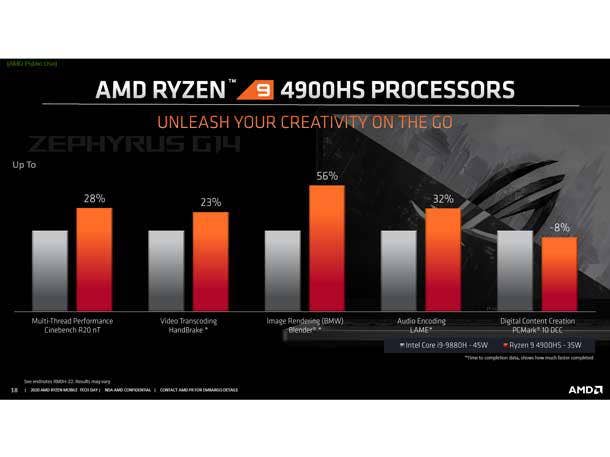AMD Ryzen 4000 H-Series CPUs Target Intel Content Creation Laptops
'The AMD Ryzen mobile 4000 series is one processor family with no compromises,' a senior product manager says of the chipmaker's new processors that will compete against Intel's dominance in gaming and content creation with the new H-series lineup.

AMD said its Ryzen 4000 H-series processors for laptops will provide better gaming and content creation experiences than Intel's top mobile processors, thanks to its 7-nanometer Zen 2 architecture.
The Santa Clara, Calif.-based chipmaker released new details of its new eight-core Ryzen 7 4800H and six-core Ryzen 5 4600H processors in addition to revealing its new flagship gaming laptop processor, the eight-core Ryzen 9 4900H, on Monday after the company revealed the new line of third-generation Ryzen mobile processors at CES 2020 in January.
[Related: AMD Reveals CDNA Server GPU Architecture, Updated EPYC Roadmap]
The company also lifted the lid on three Ryzen 4000 HS-Series processors — the Ryzen 9 4900HS, the Ryzen 7 4800HS and the Ryzen 4600HS — which bring high performance to smaller and thinner laptop form factors for gaming and content creation, thanks to their lower power draw.
While Intel continues to have the highest market share for laptop processors in terms of unit shipments — 83.8 percent, according to the latest figures from Mercury Research — AMD has steadily increased its share over the past year. In the fourth quarter of 2019, the company's laptop processor share grew 4 points to 16.2 percent over the same period last year.
The H-series processors are expected to start appearing in laptops this spring, contributing to the more than 1000 notebook designs AMD has won this year for its third-generation Ryzen mobile processors. It is one of three variants in AMD's third-generation Ryzen mobile processors, which also includes a U-series for ultrathin laptops and a Pro series for commercial laptops. All of the processors are based on AMD's 7-nanometer Zen 2 architecture that has allowed the company to claim performance gains over Intel in the desktop and server arenas.
While the company said the Ryzen 7 4800H is "one of the best gaming notebook processors today," beating Intel's ninth-generation Core i9-9880H in 3DMark Fire Strike Physics and Cinebench R20 nT[2] benchmarks for gaming and content creation, the Ryzen 9 4900H takes things a step further, providing higher clock speeds, more graphics cores and a higher graphics clock frequency than the new Ryzen 7.
"The AMD Ryzen mobile 4000 series is one processor family with no compromises," Scott Stankard, senior product manager for AMD's Ryzen 4000 mobile processors, in a digital presentation. "It delivers single- and multi-threaded leadership. It delivers graphics leadership. It delivers gaming leadership. This is the one product that delivers for all users."
The Ryzen 7 4900H comes with eight cores, 16 threads, a 3.3 GHz base frequency, a boost frequency of up to 4.4 GHz, a 12MB cache, eight graphics cores and a 1,750 MHz graphics frequency. The Ryzen 7 4800H has the same core count and cache size but lower frequencies — 2.9 GHz for base, 4.2 GHz for boost and 1,600 MHz for graphics — and seven graphics cores. The Ryzen 5 4600H comes with six cores, 12 threads, a 3 GHz base frequency, a boost frequency of up to 4 GHz, an 11MB cache, six graphics cores and 1,500 MHz in graphics frequency. All three have a 45W TDP.
The Ryzen 4000 HS-Series processors, in the meantime, have a lower TDP of 35W. But while the Ryzen 9 4900HS only differs from the H-series variant in slightly lower clock frequencies (3 GHz in base and up to 4.2 GHz in boost), the Ryzen 7 4800HS and Ryzen 5 4600HS are nearly identical in speeds and feeds to their H-series counterparts, aside from TDP.
Across multiple benchmark figures, AMD showed that its Ryzen 7 4800H can outperform Intel's Core i7-9750H in gaming and content creation when it comes to processors with a 45-watt thermal design power, or TDP, demonstrating performance gains from 5-80 percent. Only one game out of a batch of popular esports titles, League of Legends, showed a 15 percent dip in performance.
But AMD also showed a lead for its 35-watt Ryzen 9 4900HS over Intel's 45-watt i9-9880H in benchmarks for audio encoding, image rendering, video transcoding and multi-thread performance. There was one benchmark where it did not pass Intel: the PC Mark 10 DCC test for digital content creation.
"They have a 45-watt CPU. We have a 35-watt CPU, and historically that means the guy with more thermal envelope, the guy with more performance will win the day, but that is not the case with the Ryzen 4000 series processors," said Robert Hallock, senior technical marketing manager at AMD.
Hallock credited the Ryzen mobile processors' performance efficiency advanced over Intel's Core processors to the chipmaker's 7nm Zen 2 architecture, among other design decisions.
"That is directly related to the Zen 2 architecture we've built inside this CPU, our decision to move to eight cores and then 7 nm process technology, which makes it incredibly efficient," he said.
One of the first laptops to include a Ryzen 4000 HS-series processor is ASUS' Zephyrus G14, a 14-inch gaming laptop that comes with a WQHD or FHD 120-hertz display, 10 hours of battery life for video playback and a weight of 3.5 pounds.
Stankard said strong battery life will be one of the key features of new laptops coming out with AMD's Ryzen H-series and Ryzen HS-series processors.
"When we evaluate how we did at delivering world-class battery life, we feel like we accomplished our goals here," Stankard said. "Rather than hyper-optimizing for any one use case, we looked at a day-in-the-life for a typical user and optimized across all those use cases."